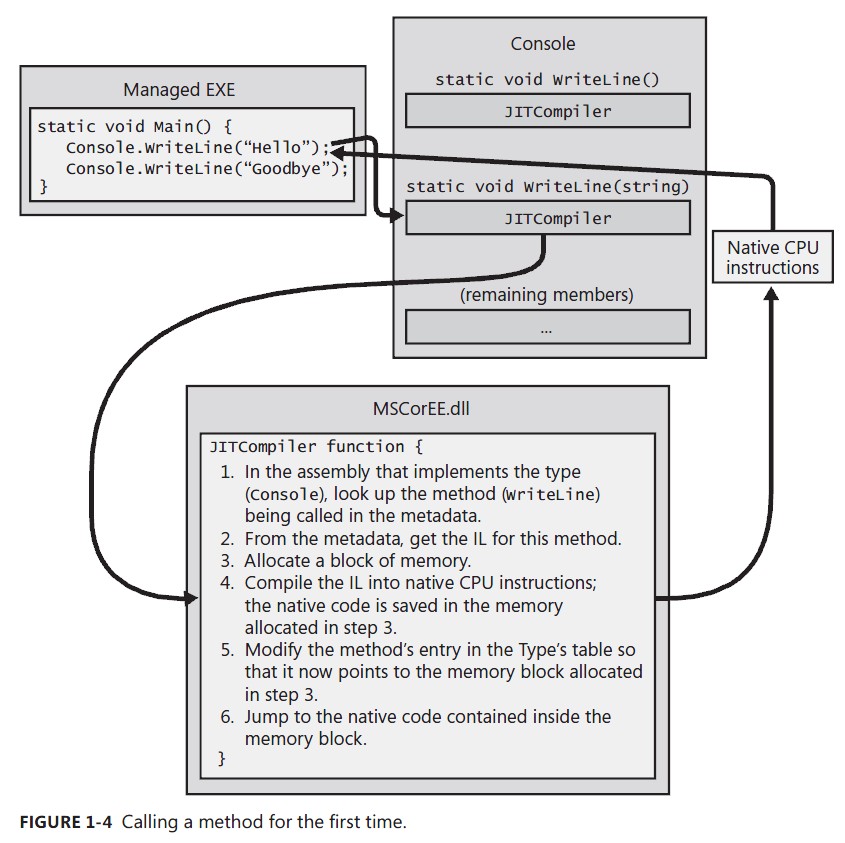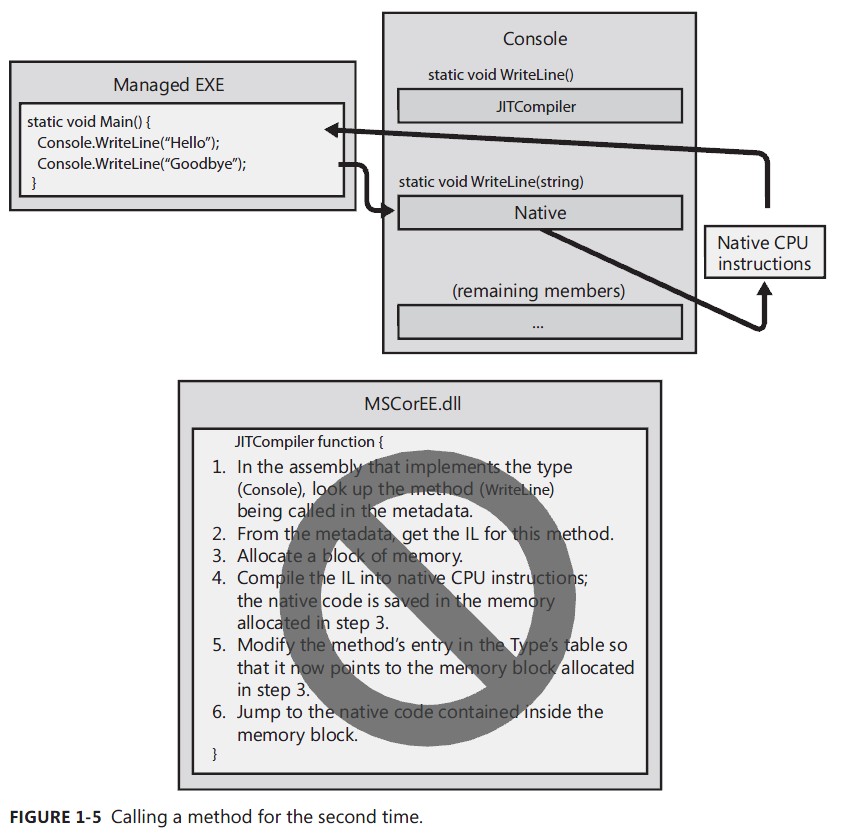The CLR’s Execution Model
The core features of the CLR
- memory management.
- assembly loading.
- security.
- exception handling.
- thread synchronization.
Managed Module
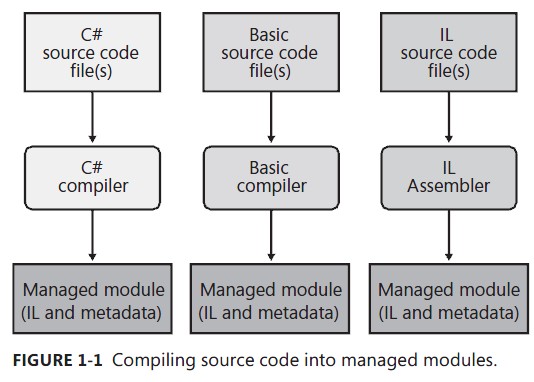
Parts of a Managed Module:
- PE32 or PE32+ header:The standard Windows PE file header, which is similar to the Common Object File Format (COFF) header. If the header uses the PE32 format, the file can run on a 32-bit or 64-bit version of Windows. If the header uses the PE32+ format, the file requires a 64-bit version of Windows to run. This header also indicates the type of file: GUI, CUI, or DLL, and contains a time stamp indicating when the file was built. For modules that contain only IL code, the bulk of the information in the PE32(+) header is ignored. For modules that contain native CPU code, this header contains information about the native CPU code.
- CLR header:Contains the information (interpreted by the CLR and utilities) that makes this a managed module. The header includes the version of the CLR required, some flags, the MethodDef metadata token of the managed module’s entry point method (Main method), and the location/size of the module’s metadata, resources, strong name, some flags, and other less interesting stuff.
- Metadata:Every managed module contains metadata tables. There are two main types of tables: tables that describe the types and members defined in your source code and tables that describe the types and members referenced by your source code.
- IL code:Code the compiler produced as it compiled the source code. At run time, the CLR compiles the IL into native CPU instructions.
In addition to emitting IL, every compiler targeting the CLR is required to emit full metadata into every managed module. In brief, metadata is a set of data tables that describe what is defined in the module, such as types and their members. In addition, metadata also has tables indicating what the managed module references, such as imported types and their members.
Metadata has many uses. Here are some of them:
- Metadata removes the need for native C/C++ header and library files when compiling because all the information about the referenced types/members is contained in the file that has the IL that implements the type/members. Compilers can read metadata directly from managed modules.
- Microsoft Visual Studio uses metadata to help you write code. Its IntelliSense feature parses metadata to tell you what methods, properties, events, and fields a type offers, and in the case of a method, what parameters the method expects.
- The CLR’s code verification process uses metadata to ensure that your code performs only “type-safe” operations. (I’ll discuss verification shortly.)
- Metadata allows an object’s fields to be serialized into a memory block, sent to another machine, and then deserialized, re-creating the object’s state on the remote machine.
- Metadata allows the garbage collector to track the lifetime of objects. For any object, the garbage collector can determine the type of the object and, from the metadata, know which fields within that object refer to other objects.
Combining Managed Modules into Assemblies
First, an assembly is a logical grouping of one or more modules or resource files. Second, an assembly is the smallest unit of reuse, security, and versioning. Depending on the choices you make with your compilers or tools, you can produce a single-file or a multifile assembly. In the CLR world, an assembly is what we would call a component.
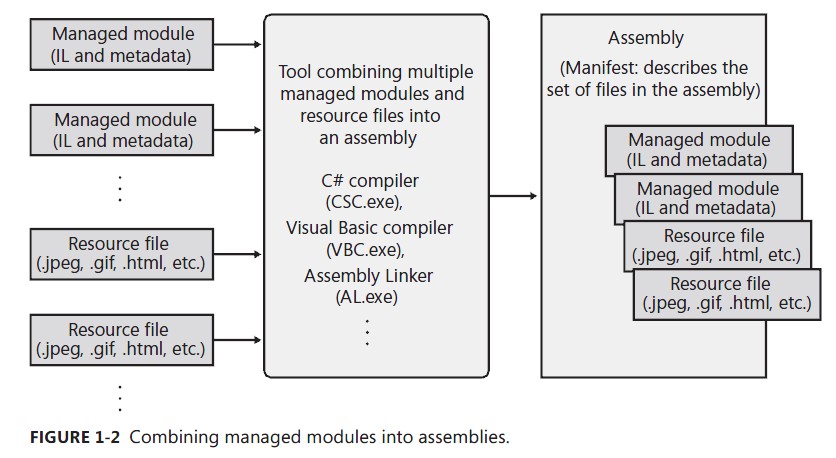
The manifest is simply another set of metadata tables. These tables describe the files that make up the assembly, the publicly exported types implemented by the files in the assembly, and the resource or data files that are associated with the assembly.
An assembly allows you to decouple the logical and physical notions of a reusable, securable, versionable component. How you partition your code and resources into different files is completely up to you. For example, you could put rarely used types or resources in separate files that are part of an assembly. The separate files could be downloaded on demand from the web as they are needed at run time. If the files are never needed, they’re never downloaded, saving disk space and reducing installation time. Assemblies allow you to break up the deployment of the files while still treating all of the files as a single collection.
An assembly’s modules also include information about referenced assemblies (including their version numbers). This information makes an assembly self-describing.
Loading the Common Language Runtime

When running an executable file, Windows examines this EXE file’s header to determine whether the application requires a 32-bit or 64-bit address space. A file with a PE32 header can run with a 32- bit or 64-bit address space, and a file with a PE32+ header requires a 64-bit address space. Windows also checks the CPU architecture information embedded inside the header to ensure that it matches the CPU type in the computer. Lastly, 64-bit versions of Windows offer a technology that allows 32-bit Windows applications to run. This technology is called WoW64 (for Windows on Windows 64).
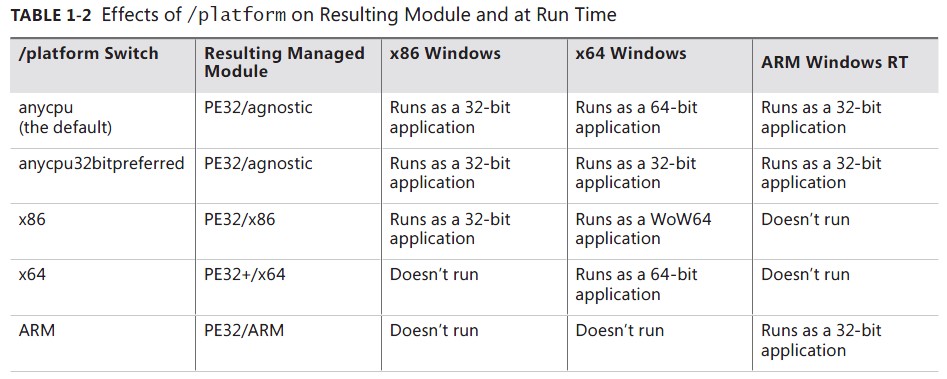
After Windows has examined the EXE file’s header to determine whether to create a 32-bit or 64- bit process, Windows loads the x86, x64, or ARM version of MSCorEE.dll into the process’s address space. On an x86 or ARM version of Windows, the 32-bit version of MSCorEE.dll can be found in the %SystemRoot%System32 directory. On an x64 version of Windows, the x86 version of MSCorEE.dll can be found in the %SystemRoot%SysWow64 directory, whereas the 64-bit version can be found in the %SystemRoot%System32 directory (for backward compatibility reasons). Then, the process’s primary thread calls a method defined inside MSCorEE.dll. This method initializes the CLR, loads the EXE assembly, and then calls its entry point method (Main). At this point, the managed application is up and running.
Executing Your Assembly’s Code
